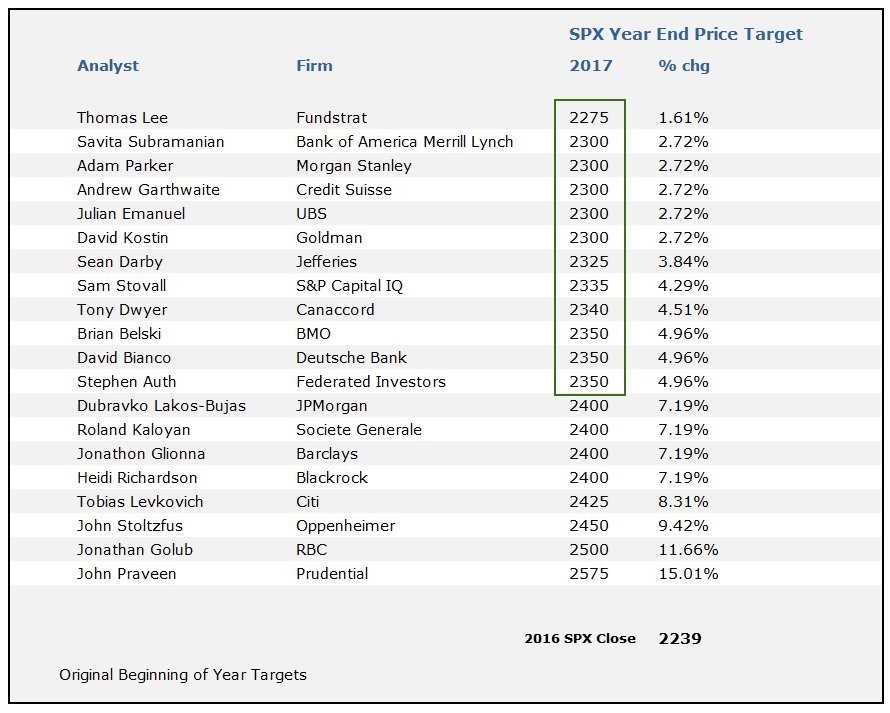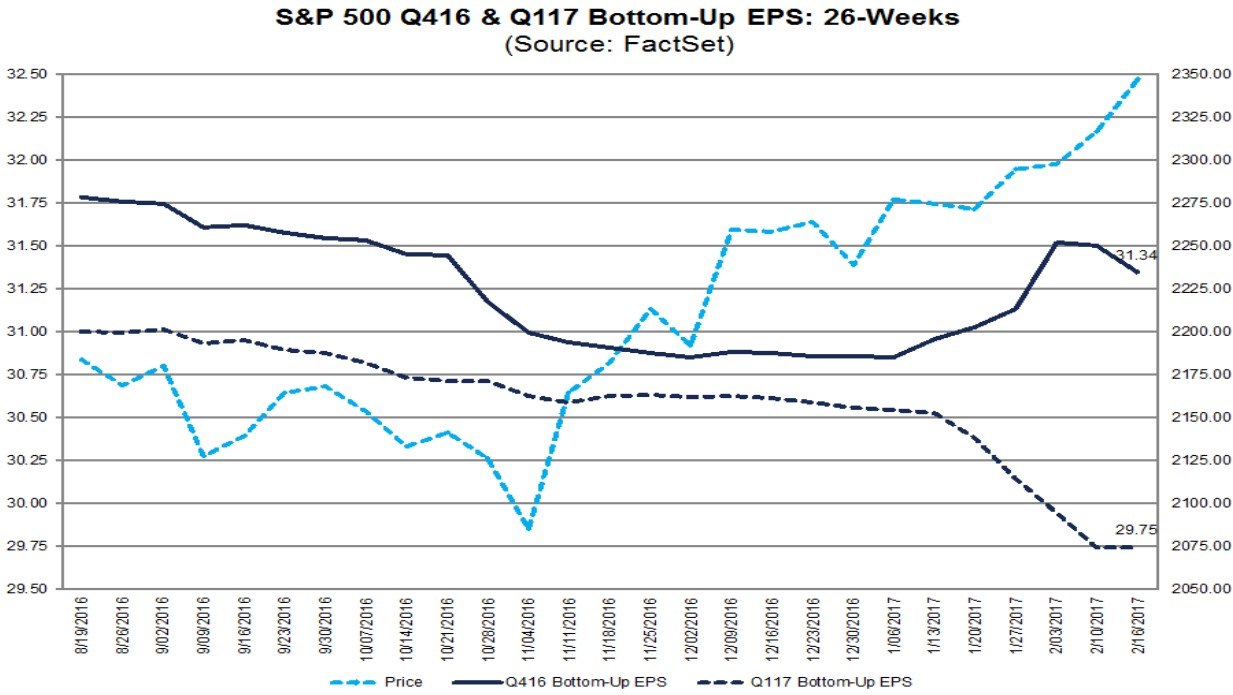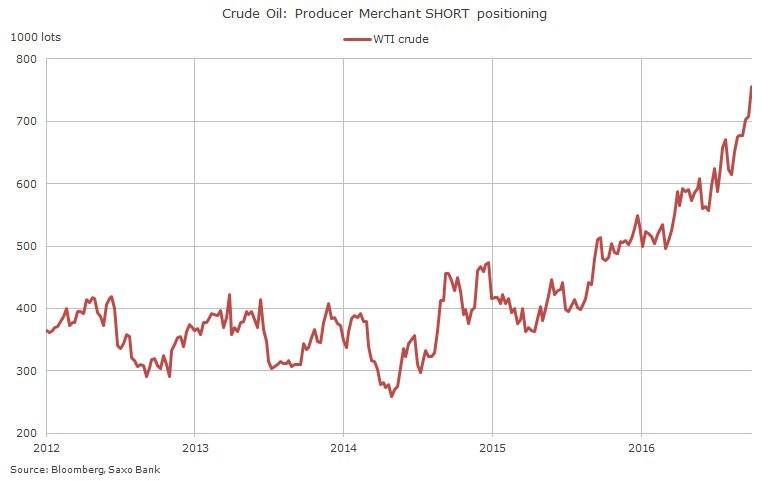Euphoria is tough to respond to as an investor. A cursory look at the market in times of enhanced excitement would make you think euphoria is great because the market is going up. Anyone who is long the market is making a boat load of money regardless of what stocks he/she owns. When optimism is too prevalent, it is nerve racking for disciplined investors. Even if you’re bullish on stocks for the long term, it feels wrong to buy stocks when everyone is doing it. I think most experienced investors believe the current period is euphoric; the market is on pace to rally over 30% this year. However, euphoria does not mean stocks will collapse. It means stocks are pricing in a great future. It depends on whether expectations are met, just like any other market. The difference is if these higher expectations aren’t met, higher losses are likely.
Moving from theory to reality, the critical part of current expectations is tax reforms and cuts passing without a hitch. The legislation passing without a hitch seems impossible because either the corporate tax rate will be cut to 20% with a border adjusted tax or it will be cut to 25% without the tax. President Trump is meeting with business leaders across the country, so whichever plan he supports will be based on what they tell him. However, he cannot perform a miracle which satisfies everyone and is deficit neutral.
The market is rallying because of these policies. It is already expensive, so that’s the only narrative that’s logical. The Shiller PE is above 29, so there’s little room for multiple expansion. The best-case scenario is for earnings to meet the 10.2% growth rate expected this year. The market is already up by half that growth rate in the first 7 weeks of the year. The start of 2017 is the exact opposite of 2016. As you can see from the chart below, 7 weeks of returns have surpassed many estimates for the whole year.

The chart below perfectly explains how the market is objectively in a euphoric stage. It shows the number of days out of the past 200 trading days the S&P 500 was down at least 1%. In the past 200 days, there has only been 5 days where it has fallen at least 1%. This is tied with the number of down days during the 2007 peak. This chart does not tell me the cycle top is necessarily here, but it does say volatility will likely increase in the next 200 days. There’s only one way to go when you’re in the basement.

Last Friday FactSet updated the aggregate Q4 earnings reports and the estimates for future earnings. I will review the important changes seen in the data. Usually by definition aggregate information ignores what’s happening at individual companies, but if a company has a particularly large loss or gain, it will move the numbers. This is the story of last week’s earnings data. AIG missed earnings estimates by $3.90 and lost $2.72 per share. There was an adverse one time charge of $3.56 per share due to the prior year’s reserve development. This one-time charge started getting factored into analysts’ estimates in the first week of February. The combined effect of the lowered estimates and then even lower actual results is the cause of Q4 earnings growth falling from 5.1% two weeks ago to 4.6% as of last Friday.
I didn’t realize the small dip last week was caused by AIG. Usually earnings estimates drift lower throughout the quarter, dip sharply before the quarter starts, and then start increasing as results start pouring in. AIG disrupted this trend. It shouldn’t distract investors from realizing this was a great quarter. AIG caused financials’ earnings growth to decline from 20% to 11%. It’s important to recognize the rising rate environment and improving business optimism is helping the banks. If these macro trends continue, they will look stronger when AIG’s huge losses aren’t repeated.

Even though blended earnings results/estimates for Q4 fell because of AIG’s one time announcement, I’d say it was a good week for earnings because the estimates for Q1 barely fell. They only fell 6 cents from last week. This increases the odds that the 10.2% earnings growth which is expected will be realized. The market keeps rallying off the chart even though the scale is changed every week. With the market rallying at a pace above earnings growth, the narrative has changed to being based on the anticipated tax cuts and regulatory reforms the Trump admiration is promising. That’s why I focused on them earlier. Everything will always come down to earnings; the proposition is that these changes will boost 2018 earnings more than expected.

There was a big decline in energy earnings estimates which is a part of my bearish thesis which appears to be playing out. This is occurring even as oil prices haven’t declined like I’ve been projecting. Last week energy earnings were expected to grow 297.1% in 2017 and now they are expected to grow 290.3%. I continue to be bearish on oil even as the price has risen moderately since I’ve gone negative. The charts get more extreme every week. As you can see in the chart below, the combined speculative gross long position in WTI and Brent hit a new record high of one billion barrels last week. The size of the speculation has increased over time, so I don’t expect a crash of the scope of 2014 or 2008, but a selloff is likely. The trade will unwind.

The chart below shows the oil producers are short 756,000 lots as of last week. The scenario remains the same. Producers are shorting at record numbers while speculators are buying at a record pace. The size of hedging in the oil market has increased with the advent of fracking firms getting hurt by the 2014 price crash. Frackers have a higher break even rate than traditional producers. After nearly going bankrupt in 2015, they are happy to hedge oil prices now that they’re above their break-even costs.

Conclusion
In summary, most of the trends we saw 2 weeks ago, continued last week. The highlight of the new data is that Q1 earnings estimates barely budged. We’ll see how long that lasts. The market doesn’t need much to rally. Accelerated earnings growth is a real reason to buy stocks which means the market will go bananas. We’ve already seen evidence of this as the S&P 500 is up 5.67% year to date.
Don Kaufman: Trade small and Live to trade another day at Theotrade.
Neither TheoTrade or any of its officers, directors, employees, other personnel, representatives, agents or independent contractors is, in such capacities, a licensed financial adviser, registered investment adviser, registered broker-dealer or FINRA|SIPC|NFA-member firm. TheoTrade does not provide investment or financial advice or make investment recommendations. TheoTrade is not in the business of transacting trades, nor does TheoTrade agree to direct your brokerage accounts or give trading advice tailored to your particular situation. Nothing contained in our content constitutes a solicitation, recommendation, promotion, or endorsement of any particular security, other investment product, transaction or investment.
Trading Futures, Options on Futures, and retail off-exchange foreign currency transactions involves substantial risk of loss and is not suitable for all investors. You should carefully consider whether trading is suitable for you in light of your circumstances, knowledge, and financial resources. You may lose all or more of your initial investment. Opinions, market data, and recommendations are subject to change at any time. Past Performance is not necessarily indicative of future results
Recommended Content
Editors’ Picks

AUD/USD: A tough barrier remains around 0.6800
AUD/USD failed to maintain the earlier surpass of the 0.6800 barrier, eventually succumbing to the late rebound in the Greenback following the Fed’s decision to lower its interest rates by50 bps.

EUR/USD still targets the 2024 peaks around 1.1200
EUR/USD added to Tuesday’s losses after the post-FOMC rebound in the US Dollar prompted the pair to give away earlier gains to three-week highs in the 1.1185-1.1190 band.

Gold surrenders gains and drops to weekly lows near $2,550
Gold prices reverses the initial uptick to record highs around the $$2,600 per ounce troy, coming under renewed downside pressure and revisiting the $2,550 zone amidst the late recovery in the US Dollar.

Ethereum could rally to $2,817 following Fed's 50 bps rate cut
Ethereum (ETH) is trading above $2,330 on Wednesday as the market is recovering following the Federal Reserve's (Fed) decision to cut interest rates by 50 basis points. Meanwhile, Ethereum exchange-traded funds (ETF) recorded $15.1 million in outflows.

UK CPI set to grow at stable 2.2% in August ahead of BoE meeting
The United Kingdom Office for National Statistics will release August Consumer Price Index figures on Wednesday. Inflation, as measured by the CPI, is one of the main factors on which the Bank of England bases its monetary policy decision, meaning the data is considered a major mover of the Pound Sterling.

Moneta Markets review 2024: All you need to know
VERIFIED In this review, the FXStreet team provides an independent and thorough analysis based on direct testing and real experiences with Moneta Markets – an excellent broker for novice to intermediate forex traders who want to broaden their knowledge base.